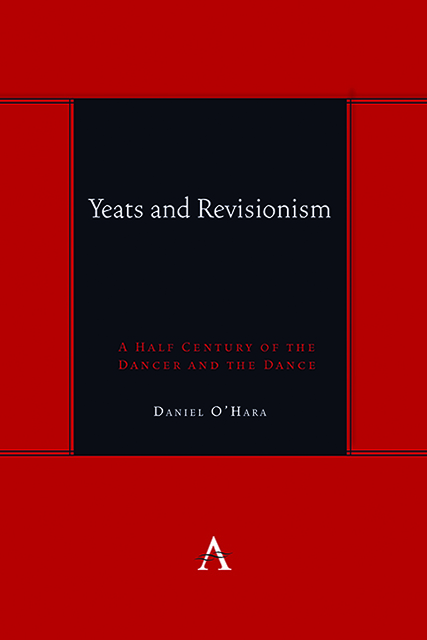Book contents
- Frontmatter
- Dedication
- Contents
- Acknowledgments
- Preface
- Introduction: Dancer and Dance: Yeats’s Romantic Modernism and Critical Revisionism
- Chapter 1 The Irony of Tradition in W.B. Yeats’s Autobiography: Dialectical Hermeneutics Beyond the New Criticism
- Chapter 2 The Specialty of Self-Victimization: On Antithetical Revisionism
- Chapter 3 Yeats in Theory: Blackmur, Bloom, De Man and Hartman
- Chapter 4 The Divisions of Yeats Studies Continued
- Chapter 5 Modernism’s Global Identity: on the Dogmatic Imagination in Yeats, Freud and Beyond
- Chapter 6 Yeats With Lacan: Toward the Real Modernism
- Chapter 7 The Spirit Medium: Yeats, Quantum Visions and Recent Lacanian Studies
- Chapter 8 And All the Ceremonies to Come: Of High Modernism, Visionary Violence and Post-Marxism
- Afterword: The Reader in Yeats
- Bibliography
- Index
Introduction: Dancer and Dance: Yeats’s Romantic Modernism and Critical Revisionism
Published online by Cambridge University Press: 08 June 2023
- Frontmatter
- Dedication
- Contents
- Acknowledgments
- Preface
- Introduction: Dancer and Dance: Yeats’s Romantic Modernism and Critical Revisionism
- Chapter 1 The Irony of Tradition in W.B. Yeats’s Autobiography: Dialectical Hermeneutics Beyond the New Criticism
- Chapter 2 The Specialty of Self-Victimization: On Antithetical Revisionism
- Chapter 3 Yeats in Theory: Blackmur, Bloom, De Man and Hartman
- Chapter 4 The Divisions of Yeats Studies Continued
- Chapter 5 Modernism’s Global Identity: on the Dogmatic Imagination in Yeats, Freud and Beyond
- Chapter 6 Yeats With Lacan: Toward the Real Modernism
- Chapter 7 The Spirit Medium: Yeats, Quantum Visions and Recent Lacanian Studies
- Chapter 8 And All the Ceremonies to Come: Of High Modernism, Visionary Violence and Post-Marxism
- Afterword: The Reader in Yeats
- Bibliography
- Index
Summary
It would be facile to claim, as my title may appear to do, that the momentous transformation in literary studies that Frank Kermode's Romantic Image and Jean-Michael Rabaté's The Future of Theory permit us to reflect critically upon comes down to a mere shift in point of view. More must be involved than a change from a focus on the individual author suffering in isolation to produce his or her radiant work of beauty with an uncanny life all its own, to an investigation of the sublime spectacle of all the minute processes, however identified and analyzed, by which any subject is formed (and deformed) as it deposits its traces in the real or virtual archives of the present moment. Nonetheless, for purposes of initial clarification at least, I think it is accurate to say that a general shift of this sort, from placing the critical perspective on the dancer (so to speak) to placing it on the dance (a shift from aesthetic product to social process), has indeed occurred in the 45 years between the original publication of Frank Kermode's Romantic Image in 1957 and Jean-Michel Rabaté's The Future of Theory in 2002. Ironically or not, the imagery of dancer and dance, so central to Kermode's study (even more so than that of the tree, the obvious symbol of Romantic organicism), does reappear in Rabaté's book, as we shall see, at a crucial moment in its argument.
But before opening my own argument, I want to present the most famous passage celebrating the vision of dancer and dance in modernist literature, the concluding stanza of W. B. Yeats's magisterial meditation on the complex interchanges between life and art, “Among School Children”:
Labour is blossoming or dancing where
The body is not bruised to pleasure soul,
Nor beauty born out of its own despair,
Nor blear-eyed wisdom out of midnight oil.
O chestnut tree, great rooted blossomed,
Are you the leaf, the blossom or the bole?
O body swayed to music, O brightening glance,
How can we know the dancer from the dance?
Now is not the occasion to do a complete reading of this visionary scene of dancer and dance, although some interesting unanswered questions about it could be raised: Where do dancer and tree suddenly come from, their having made no earlier appearance in the poem at all?
- Type
- Chapter
- Information
- Yeats and RevisionismA Half Century of the Dancer and the Dance, pp. 1 - 18Publisher: Anthem PressPrint publication year: 2022



